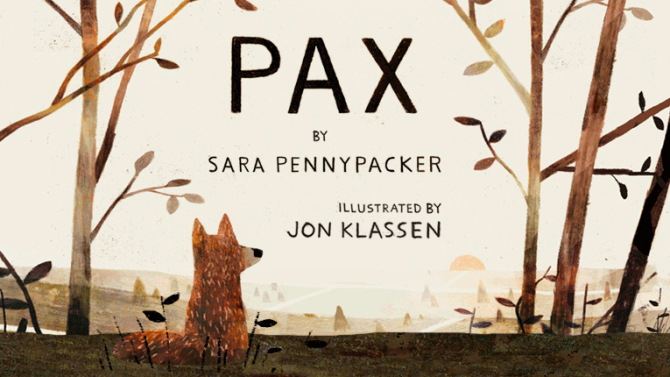
Review by Lesley Finn
Pax
by Sara Pennypacker
Harper Collins, 2016
In the opening pages of Sara Pennypacker’s new novel, twelve-year-old Peter plays fetch with his pet in the woods. The idyll is all artifice: this is a scene of farewell, and a forced one at that. War looms. Peter’s father enlists in the military, and in answering the call to duty, he forces his son to make two sacrifices. The boy must make a new home with his grandfather 300 miles away, but first must release his pet, a domesticated red fox called Pax, back into the wild; a place the animal has never known.
Peter, in numbed obedience to his father, throws Pax’s favourite toy long into the deep green. The fox chases, and so begins the separation that structures this mesmerizing story about the extraordinary bonds between children, animals, and the adults who do and do not understand them.
Soon after arriving at his grandfather’s house, Peter decides he must right the wrong pushed on him by the adult world. He runs away and sets out to find his fox. Alongside him in the narrative, but an immense distance away, Pax begins his own journey to rediscover his animal nature. In many ways, Pax provides an exemplum of the classic quest narrative: there are obstacles, ranging from broken bones to land mines, mentors, and a break with the old way of living. The brilliance of Pennypacker’s work lies not in the masterful execution of this form, but in the stunningly observed perspectives of fox and boy that alternate chapter by chapter.
Pennypacker renders Peter’s world as one beset by the untenable logic of adult needs. As such, the stretches of Peter’s narrative lack certain specifics; the war of the book, for example, remains unnamed and unexplained. But cultural references poke through the blanket of grey antagonism, and they are ones rooted in childhood experience: baseball, peanut butter, a Magic 8 Ball toy. To Peter, rules and restrictions tumble, as in that plastic oracle, from some random force; his challenge comes in the form of accepting that very randomness and following the one thing he knows—his love for Pax. The specificity of Peter’s world, then, is one of sense and memory: the bristly fur of Pax’s coat, the lurching exhilaration of chasing a bird. Such flashes of sensory intensity within the frustrating macrocosm of the tween make this book fizz with emotional truth.
And then there is Pax. The chapters given to the animal’s perspective are reason alone to read this novel. Utterly joyful and always, even in their darkest moments, devoid of sentimentality, Pax’s chapters bring us down to the forest floor, while illuminating Peter’s experience through the animal’s stitched together understanding of the human world. Faced with the increasing carnage of the war ripping through the forest, Pax thinks of when his humans were most connected, and shares a startling image of how reading might appear to the unfamiliar: people sitting together, at peace, with “a hard box, flat and thin and made of many layers of paper” resting on their laps. (140) Pax enables us to be on the outside looking in, and that fresh perspective affords instance after instance of gorgeous insight.
Pennypacker’s language in these fox chapters soars with poetic beauty and effortless ease; we slip into Pax’s experience as though we lived among the trees all along. The reader, tacking between Pax’s world and Peter’s, links the parted friends. If this meta-concept of merging seems beyond the confines of a book aimed at 10-13 year olds, consider the scene of Pax resting with Gray, an elder fox on the verge of death after a mine explosion: “He could only offer withness, but nothing else was asked. Linked with Gray’s final memories, he heard the song of an arctic bird instead of the humans’ shouts. Instead of the ashy haze that hung over them, he saw with Gray a vast blue bowl of sky. Instead of lying on gritted ground, he tumbled with Gray and his brother kits across a snowy tundra spiked with starry blue flowers. He purred with Gray under his silver mother’s rough tongue, tasted her warm milk, felt the weight of her chin resting over his newborn skull. And then peace.” (158)
“Withness” provides the only tangible comfort in this story, and it is something, Pennypacker suggests, that may be more accessible to children and animals than to the war-sick adults who surround them. How do we connect when the separation seems so vast and unbridgeable? The imaginative empathy of childhood provides a good start.
Lesley Finn is an MFA candidate at the University of British Columbia. Her work most recently appeared in Litro Magazine.